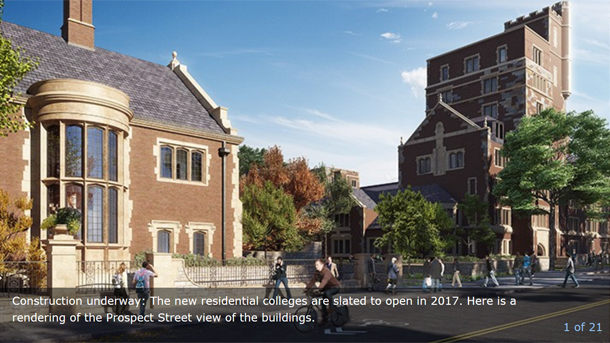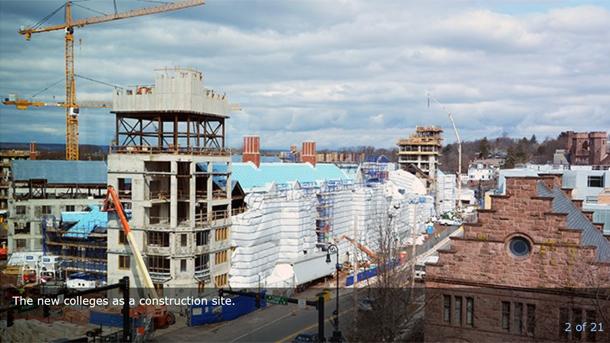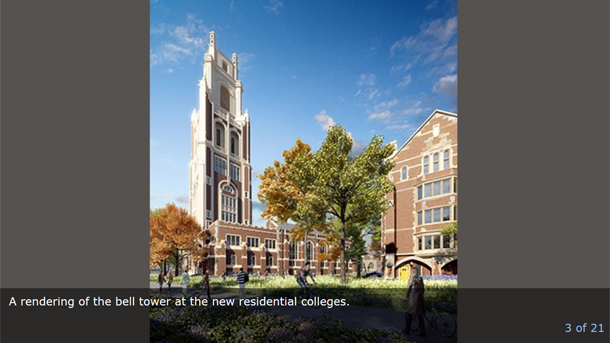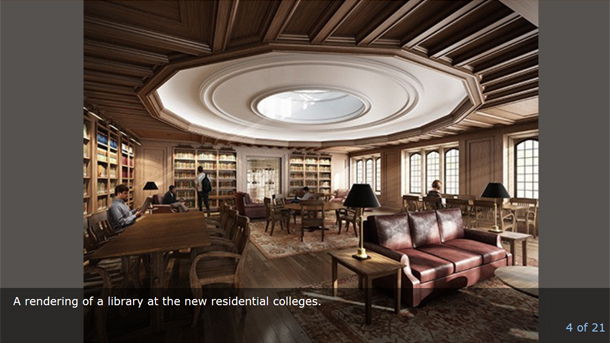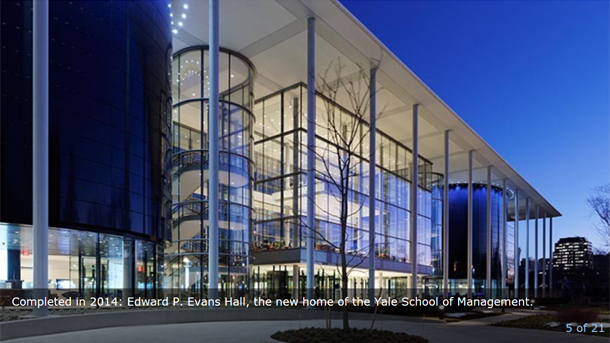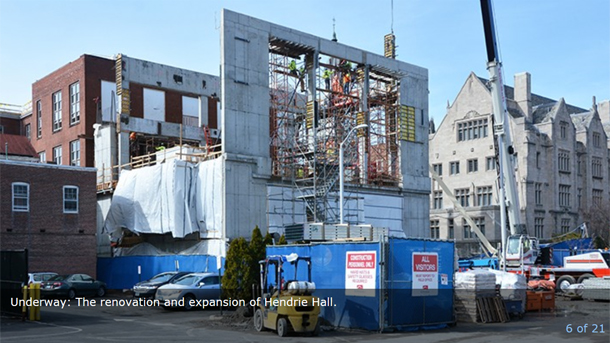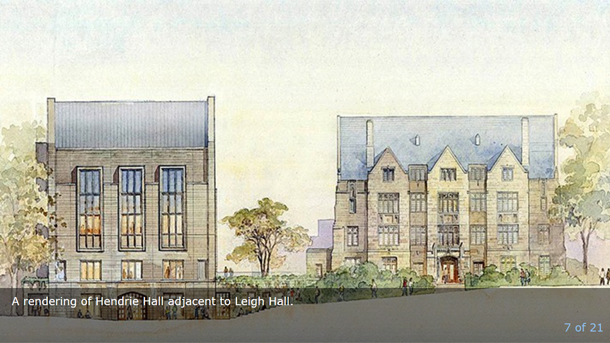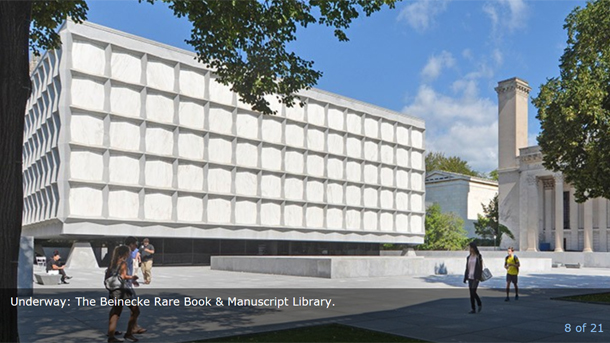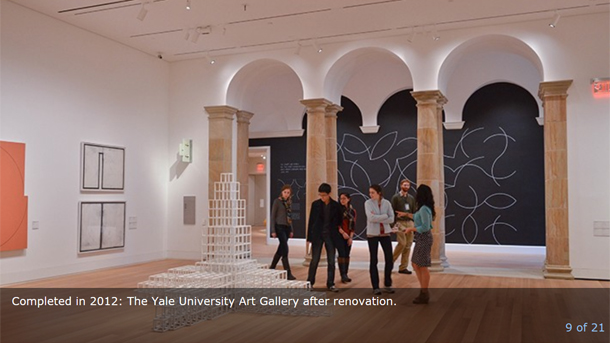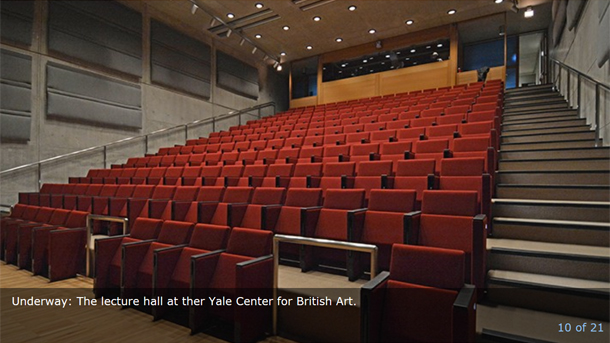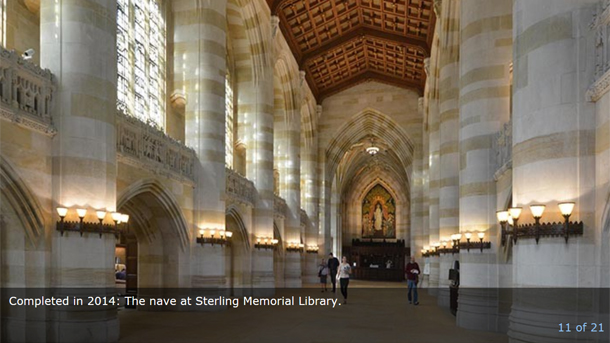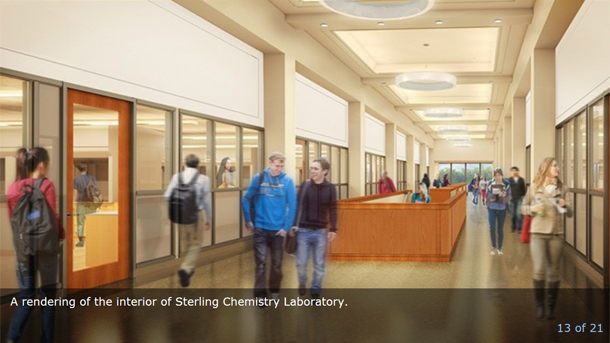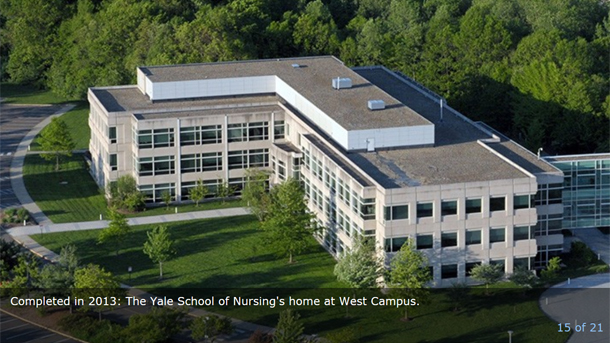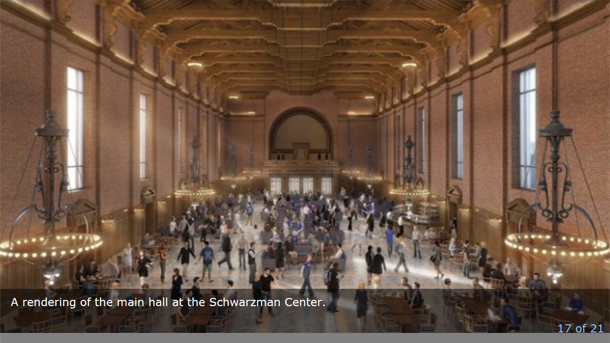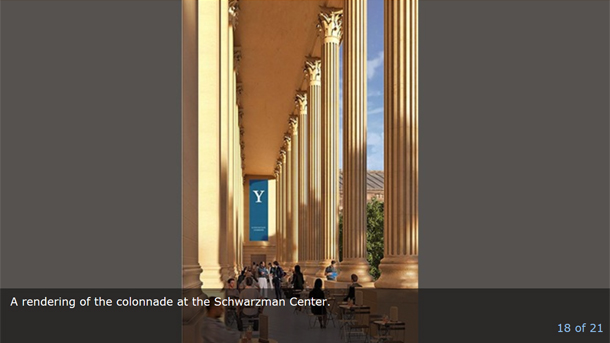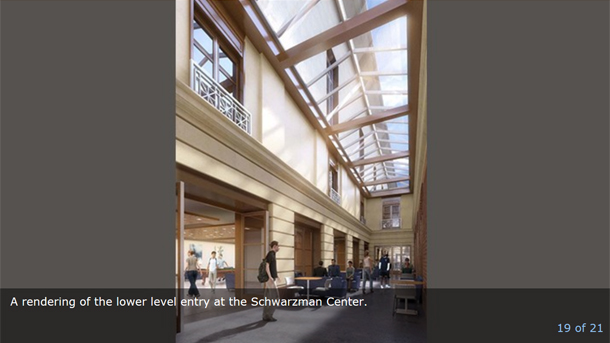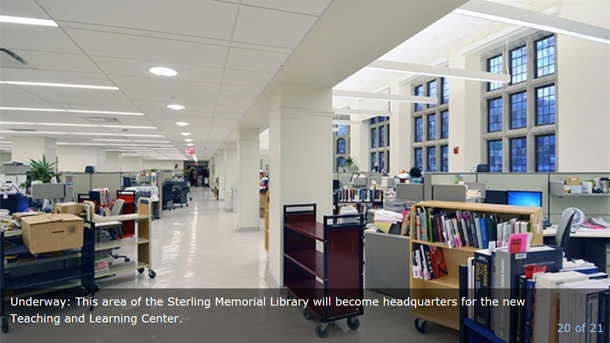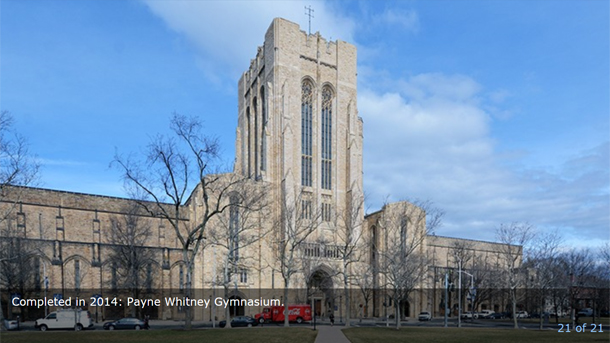Class News
Class of 1964 Gateway progresses in new residential colleges
The major gateway to South College (one of the two new residential colleges) will be named in honor of the Class of 1964. You can see an architect's drawing of the gateway here. The following YaleNews story gives an overview of Yale's major renovation projects currently in progress, including a time-lapse video of the construction site of the new residential colleges.
YaleNews
March 8, 2016
Images change every 8 seconds
The cranes that have loomed over the campus in recent months will be a less common sight in the near future as Yale nears the completion of five major renovation projects.
“The cranes dotting the Yale landscape are a visible reminder of how many [building projects] are now in progress. …” wrote Provost Benjamin Polak in his annual update on university construction on March 3. “[T]he cranes are a visible manifestation of the work underway to transform our campus and our community.”
Renovations of Hendrie Hall (165 Elm St.), the Beinecke Rare Book and Manuscript Library (121 Wall St.), the Yale Center for British Art (1080 Chapel St.), Sterling Chemistry Laboratory (225 Prospect St.), and Wright Laboratory (266 Whitney Ave.) will be finished in time for the start of fall semester, said Polak.
“From the outside, these sites — and the structures they represent — are as varied in architectural style and day-to-day use as they are united in a sense of purpose. …” wrote the provost. “[T]he buildings’ very different looks belie a common strategic thread. Each is designed to underpin our education and research mission. Each will provide carefully conceived space for courses, lab work, and practice. And each is informed by our overarching goal to be a leader in the artistic disciplines, in scientific discovery, and everywhere between.”
Modernizing while preserving
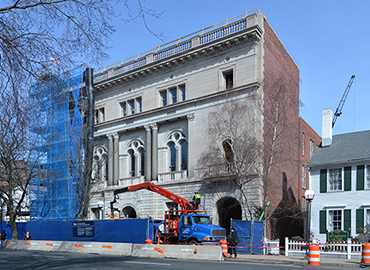
Hendrie Hall's exterior may look the same,
but there have been many changes inside.
As Yale has renovated its historic buildings to make them modern and cutting-edge, the university has taken great care to preserve their architectural integrity.
For instance, Hendrie Hall, a Renaissance Revival structure that dates back to 1892, will retain its Venetian palazzo exterior. Inside, however, it has been reconfigured to include state-of-the-art rehearsal facilities, studios, and practice rooms for faculty members, undergraduates, and graduate students; a new orchestra hall; a digital recording studio; and a common area/gathering space. The building will be the flagship of the newly christened Adams Center for Musical Arts.
Similarly, while the familiar honeycombed marble, granite, and glass exterior of the Beinecke Rare Book and Manuscript Library (1963) remains unchanged, the interior has been refurbished to provide expanded teaching spaces and greater access to its world-renowned collections.
Balancing access and architecture has also been a focus at the Yale Center for British Art (1977).
“When the Yale Center for British Art reopens its doors later this spring,” said Amy Meyers, the center’s director and professor adjunct of the history of art, “visitors — from students, faculty, and staff, to members of the wider public — will experience our magnificent collections as Louis Kahn envisioned them when he designed the building, in concert with the institution’s first director, Professor Jules David Prown: in spaces that invite contemplation, that draw viewers to engage personally with the installations, and that inspire awe just as the paintings, sculptures, and other works on display do so.
“It is particularly fitting,” Meyers continued, “that we are witnessing the center’s rebirth in the same year that our sister institution, the Paul Mellon Centre for Studies in British Art in London, has reopened after refurbishment and significant expansion. Together, they will secure the legacy and rich traditions of British art for the next generation and beyond, very much in the spirit of both institutions’ founder, Paul Mellon (Yale College, Class of 1929).”
On Science Hill, Sterling Chemistry Laboratory (SCL), a Gothic structure built in 1923, is being transformed into a space where chemists, biologists, and physicists intermingle. Changes there include improvements to teaching and research space, accessibility, and safety; new undergraduate teaching laboratories, lab support, offices, and student common areas; and new mechanical, electrical, and plumbing systems.
Once a bunker that housed a nuclear particle accelerator, Wright Laboratory (1966) will instead be a place where physicists conduct research on neutrinos and dark matter.
“As the provost noted, the renovations being completed this year are part of an overarching effort to dramatically expand our resources for faculty and students on Science Hill,” said Steve Girvin, deputy provost for research and the Eugene Higgins Professor of Physics. “The new undergraduate teaching labs in SCL will be fabulous modern spaces which we can be proud to show prospective Yale College students with interest in the STEM [science, technology, engineering, and math] disciplines.
“Meanwhile, the reimagination of Wright Lab under the leadership of [professor of physics] Karsten Heeger is defining a major new direction for the physical sciences at Yale,” he continued. “It will house some of the faculty moving out of Gibbs [at 260 Whiney Ave.], provide great spaces for the construction of very large instruments and detectors, and provide a home for the machine shops — both student-geared and professional — that are vital to research.
“These renovations, and the Yale Science Building project that will soon follow, will provide rich opportunities for our faculty and students, foster a cross-disciplinary approach to science that sets Yale apart from its peers, and transform research and education on Science Hill and beyond,” said Girvin.
Looking ahead to next year, another iconic campus space is being carefully restored and reinvented, as the Gothic stone walls of the Sterling Memorial Library (1930) prepare to house the newly unified Yale Center for Teaching and Learning (CTL). In a historic yet state-of-the-art facility, the CTL will offer flexible classroom and collaboration spaces and a “learning studio” where faculty can experiment with digital tools.
“The new space will help us realize the vision of providing a campus-wide resource to promote excellence in teaching and learning,” said Jennifer Frederick, the center’s executive director, “and the central location in a signature Yale building reinforces the message that education is a core part of the university’s mission. We look forward to continuing the work of CTL in our new home in Sterling Memorial Library.”
On the horizon: five years, five major projects
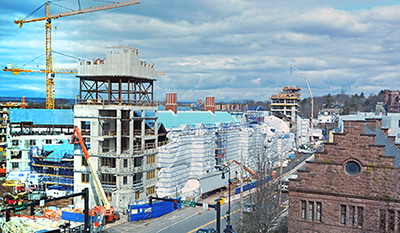
There have been as many as 11 cranes
at the site of the new residential colleges.
Even as these projects are coming to a conclusion, the rapid pace of construction and renovation will continue on campus, with a major project due to be completed in each of the next five years.
2017 — Residential Colleges. Construction has continued throughout the winter at the site of the new colleges, on the corner of Sachem and Prospect streets, where some days up to 11 cranes could be seen. The structural frames of the buildings are largely complete, so all but one crane will disappear, while work on the exterior and interior of the colleges continues. The residential buildings will allow Yale College to admit 200 more students per class — the first major growth in class size since the advent of co-education in 1969. (Watch a time-lapse video of the construction, below.)
2018 — Housing complex for graduate and professional students. This fully modern facility, centrally located on Elm Street, will provide high-quality housing that responds to students’ needs and desires — including kitchens and common rooms.
2019 — Yale Science Building. The newest structure on Science Hill will embody the university’s goal of taking a broader approach to science teaching and research by bringing together diverse disciplines in one place to foster new synergies.
2020 — Schwarzman Center. Thanks to a $150 million gift from Blackstone founder Stephen A. Schwarzman ’69, the historic Commons and Memorial Hall will be transformed into a state-of-the-art center serving all students and offering a variety of meeting/activity spaces and programming. The four floors of the 114-year-old complex total over 87,000 square feet.
2021 — Humanities hub.The Hall of Graduate Studies at 320 York St. will be reborn as a central home for the humanities at Yale, bringing together faculty and students in new ways that transcend traditional disciplinary boundaries and promote new collaborations.
A vision for the future
At the conclusion of the provost’s update on campus construction, he noted that “throughout, the President’s seven key goals are mirrored in what we are building,” referring to the ambitions for the university outlined by President Peter Salovey.
“From the new campuses for the School of Management and the School of Nursing to the refurbishment and reinvention of landmark facilities like Payne Whitney Gymnasium and the Yale University Art Gallery, our recent building efforts have united form, function, and strategic vision,” Salovey said. “I anticipate with enthusiasm the projects we will complete this year, and those that will follow in the decade ahead. We will continue to pursue our campus planning in alignment with Yale’s core mission of education and research.”


